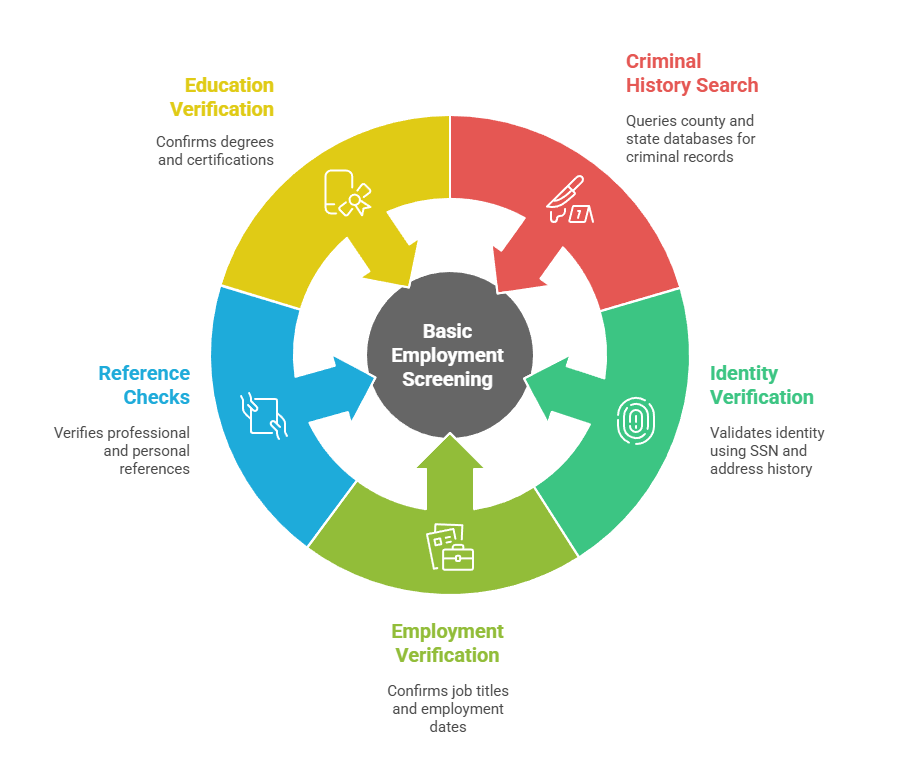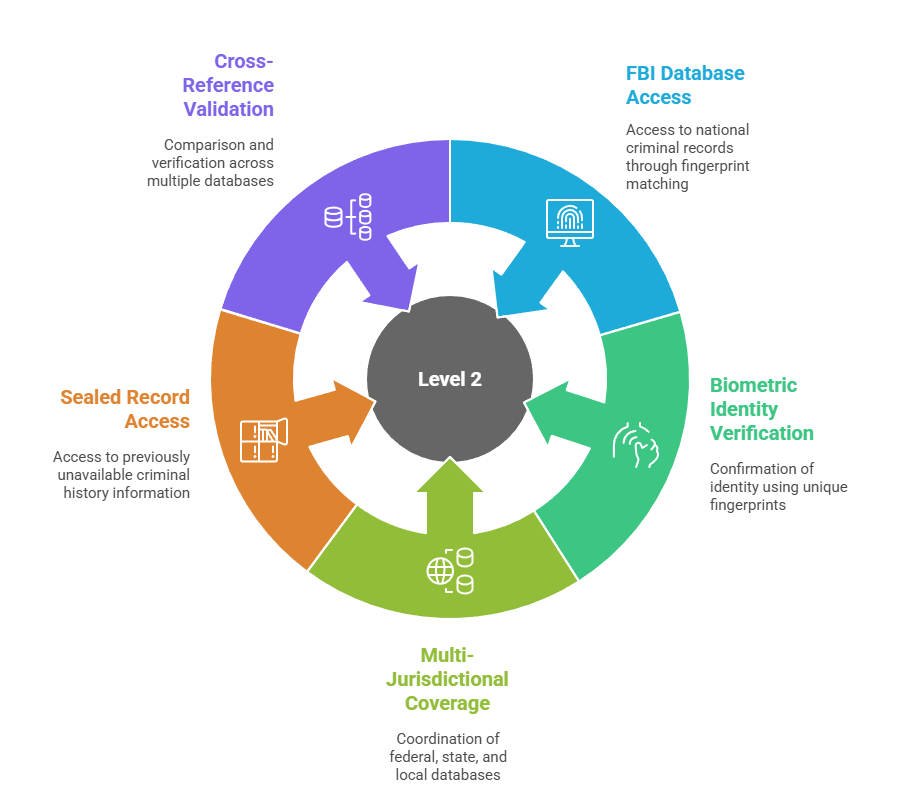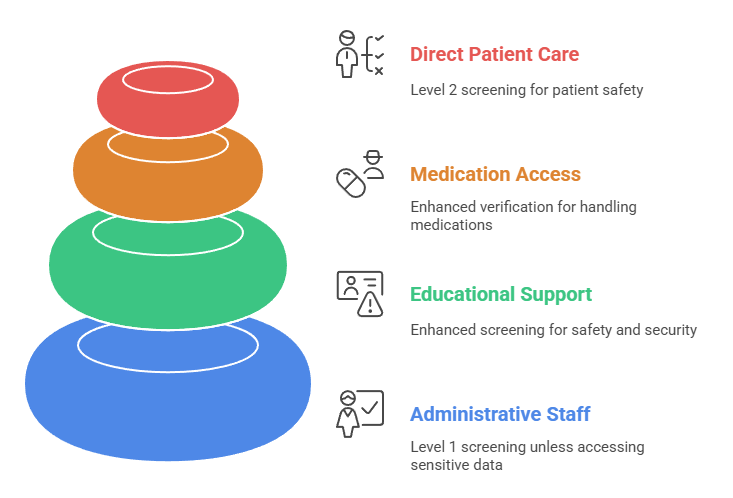Level 1 and Level 2 background checks represent different depths of pre-employment screening, with Level 1 covering basic criminal history and identity verification, while Level 2 includes comprehensive fingerprint-based searches and additional security clearances. Understanding these background check levels explained helps both employers and job seekers navigate employment screening requirements effectively.
Key Takeaways
- Level 1 background checks typically include basic criminal history searches, employment verification, and reference checks without fingerprint requirements.
- Level 2 background checks require FBI fingerprint screening, comprehensive criminal database searches, and enhanced security clearance protocols.
- Fingerprint background check requirements are mandatory for Level 2 screenings and positions involving vulnerable populations or high security needs.
- Employment screening levels vary by industry, with healthcare, education, and finance requiring more extensive Level 2 verification processes.
- Processing timeframes differ significantly, with Level 1 checks completing in 1-3 business days versus 5-14 days for Level 2 screenings.
- FCRA compliance requirements apply to both levels, ensuring fair and accurate reporting of background check information to employers.
Understanding Background Check Levels: The Foundation of Employment Screening
Background check depth comparison begins with understanding how screening levels categorize the thoroughness of pre-employment verification. These standardized levels help employers match screening intensity with job requirements and security needs. The classification system ensures consistent application across industries while maintaining compliance with federal and state regulations.
Different industries require varying levels of scrutiny based on job responsibilities and potential risks. Level 1 background check components focus on immediate safety concerns and basic qualifications. Meanwhile, Level 2 screenings dive deeper into an applicant's history through enhanced database searches and biometric verification.
The evolution of employment verification has led to more sophisticated screening methods. Modern background checks integrate multiple databases and verification sources to provide comprehensive applicant profiles. This systematic approach helps employers make informed hiring decisions while protecting their organizations and customers. Additionally, technological advances have streamlined the verification process, reducing human error and improving accuracy across all screening levels.
Level 1 Background Check Components and Requirements
Core Elements of Basic Employment Screening
Level 1 background checks form the foundation of most pre-employment screening processes. These checks typically include criminal history search at county and state levels, identity verification through Social Security number validation, and basic employment history confirmation. The screening process focuses on immediate safety concerns and fundamental qualifications without requiring extensive waiting periods.

- Criminal History Search: County and state-level database queries
- Identity Verification: Social Security number and address history validation
- Employment Verification: Confirmation of previous job titles and employment dates
- Reference Checks: Professional and personal reference verification
- Education Verification: Degree and certification confirmation when applicable
Most Level 1 screenings complete within 1-3 business days, making them ideal for high-volume hiring or positions with immediate start dates. The streamlined process balances thoroughness with efficiency while maintaining FCRA compliance standards.
Industries Commonly Using Level 1 Screening
Retail, hospitality, and general office positions typically utilize Level 1 background checks for their hiring processes. These industries prioritize quick turnaround times while ensuring basic safety and reliability standards.
Customer service roles, warehouse positions, and entry-level administrative jobs benefit from Level 1 screening efficiency. Employers can quickly identify disqualifying factors while avoiding unnecessary delays in the hiring process. This approach supports business continuity and operational needs in fast-paced environments.
Typical Level 1 Processing Timeline
Standard Level 1 screenings follow a predictable processing schedule that supports efficient hiring decisions. Most criminal database searches complete within 24-48 hours of submission. Employment verification typically requires 1-2 additional business days depending on previous employer responsiveness.
Reference checks often represent the longest component of Level 1 screening. Personal and professional references may require multiple contact attempts across different time zones. However, many employers proceed with conditional offers while completing reference verification to avoid hiring delays.
Level 2 Background Check: Comprehensive Screening Standards
Level 2 fingerprint requirements represent the most thorough form of employment screening available to most employers. This enhanced screening process mandates FBI database searches through biometric fingerprint analysis, ensuring comprehensive criminal history coverage across all jurisdictions. The fingerprint screening component eliminates identity fraud possibilities while providing access to sealed or restricted criminal records.

- Enhanced Criminal Search: FBI database access through fingerprint matching
- Biometric Identity Verification: Foolproof identity confirmation through unique fingerprints
- Multi-Jurisdictional Coverage: Federal, state, and local database coordination
- Sealed Record Access: Previously unavailable criminal history information
- Cross-Reference Validation: Multiple database comparison and verification
Enhanced security clearance protocols accompany Level 2 screenings, including credit history analysis, drug testing requirements, and extensive reference verification. The process involves multiple verification points and cross-referencing between federal, state, and local databases. Background investigators may conduct personal interviews and neighbor contacts for sensitive positions.
Complete Comparison: Level 1 vs Level 2 Background Check
Understanding the fundamental differences between screening levels helps employers select appropriate verification methods for their hiring needs. Level 1 checks provide adequate protection for standard employment positions without sensitive information access. However, Level 2 screenings become essential when job responsibilities involve vulnerable populations or security-sensitive materials.
| Feature | Level 1 Background Check | Level 2 Background Check |
| Fingerprint Requirement | Not Required | FBI Fingerprint Mandatory |
| Criminal Database Access | County/State Databases | Federal + All Jurisdictions |
| Processing Timeline | 1-3 Business Days | 5-14 Business Days |
| Cost Range | $25-$75 | $75-$150 |
| Identity Verification | Basic SSN Validation | Biometric Fingerprint Match |
| Sealed Record Access | Limited Access | Full FBI Database Access |
The fundamental difference between these screening levels lies in database access and verification methods. Level 1 checks rely primarily on public record searches and digital database queries. Conversely, Level 2 screenings utilize government-authorized fingerprint systems that access restricted law enforcement databases unavailable through standard background check services.
Industry-Specific Background Check Requirements
Healthcare and Education Mandates
Healthcare facilities and educational institutions face strict regulatory requirements for employee background verification. Level 2 fingerprint screening becomes mandatory for positions involving patient care, medication access, or student interaction. State licensing boards often require enhanced screening as a condition of professional certification renewal.

- Direct Patient Care Roles: Level 2 screening required for nurses, doctors, and medical assistants
- Medication Access Positions: Pharmacists, pharmacy technicians, and medication aides need enhanced verification
- Administrative Healthcare Staff: Level 1 adequate unless accessing patient records or controlled substances
- Educational Support Staff: Custodians, food service, and transportation personnel require enhanced screening
Healthcare screening protocols protect vulnerable patient populations while maintaining industry credibility. Enhanced verification helps prevent medication diversion and patient abuse incidents. Educational institutions balance student safety with efficient hiring practices through appropriate screening level selection.
Financial Services and Security Industries
Financial institutions implement comprehensive screening protocols to protect customer assets and sensitive information. Level 2 background checks become standard for positions involving money handling, customer data access, or regulatory compliance responsibilities.
Security services companies require extensive background verification for armed and unarmed security personnel. Level 2 screening ensures proper vetting for individuals protecting people, property, and assets. The thorough verification process supports licensing requirements and insurance compliance across different security specializations.
Government and Public Sector Positions
Government agencies utilize Level 2 screening for most civil service positions involving public trust responsibilities. Federal employment typically requires enhanced background verification regardless of specific job duties. State and local government positions involving sensitive information or public safety responsibilities mandate comprehensive screening protocols.
Public sector screening extends beyond basic criminal history to include financial responsibility assessment. Credit checks become standard for positions involving budget management or procurement responsibilities. Additionally, government screening may include polygraph examinations for law enforcement and intelligence positions.
Cost Analysis and Processing Timeframes
Pre-employment screening costs vary significantly based on screening depth and geographic location. Level 1 background check components typically range from $25-$75 per applicant, while Level 2 fingerprint requirements increase costs to $75-$150 per screening. Additional components like drug testing, credit checks, or reference verification add supplementary charges to the base screening price.
Processing timeframes directly impact hiring efficiency and candidate experience. Level 1 screenings complete within 1-3 business days for most applicants, supporting quick hiring decisions and immediate start dates. Level 2 verifications require 5-14 business days due to fingerprint processing and federal database coordination, potentially extending the hiring timeline significantly.
- Volume Pricing: Bulk screening packages reduce per-applicant costs
- Geographic Variations: Urban areas often offer competitive pricing options
- Seasonal Fluctuations: High-volume hiring periods may increase processing times
- Rush Processing: Expedited services available at premium pricing
Smart employers balance thoroughness with efficiency by matching screening levels to actual job requirements. Over-screening low-risk positions wastes resources and creates unnecessary hiring delays. Conversely, under-screening high-risk roles exposes organizations to potential liability and security breaches.
Legal Compliance and FCRA Requirements
FCRA compliance forms the cornerstone of legally defensible background check processes regardless of screening level. The Fair Credit Reporting Act mandates specific disclosure requirements, consent procedures, and adverse action protocols for all employment-related background checks. Employers must provide clear notification of screening intentions and obtain written consent before initiating verification processes.
Both Level 1 and Level 2 screenings must follow identical FCRA protocols despite their different verification depths. Pre-adverse action notices become required when background check results may negatively impact hiring decisions. The standardized process protects both employers and applicants while ensuring fair and consistent application of screening criteria.
Criminal history search results require careful interpretation to avoid discriminatory practices. The Equal Employment Opportunity Commission provides guidance on considering conviction records in hiring decisions. Employers must evaluate the relationship between criminal history and job responsibilities rather than implementing blanket exclusion policies.
Technology and Innovation in Background Screening
Modern background check technology has revolutionized both Level 1 and Level 2 screening processes. Automated database searches reduce processing times while improving accuracy across multiple verification points. Real-time status updates keep employers and candidates informed throughout the screening process. Furthermore, mobile-friendly interfaces enable remote fingerprint collection and document submission.
Artificial intelligence algorithms now assist in record matching and identity verification processes. Machine learning systems identify potential discrepancies or fraud indicators that human reviewers might miss. These technological advances support faster decision-making while maintaining verification accuracy standards.
Best Practices for Employers

Successful background check programs require clear policies that outline screening requirements for different position types. Job descriptions should specify required screening levels to set appropriate candidate expectations. Consistent application of screening criteria protects employers from discrimination claims while ensuring fair treatment of all applicants.
Training hiring managers on FCRA compliance requirements prevents costly legal violations. Regular policy reviews ensure screening practices remain current with changing regulations and industry standards. Additionally, partnering with reputable background check providers ensures accurate results and regulatory compliance.
Impact on Candidate Experience
Background check processes significantly influence candidate perceptions of employer professionalism and organization. Clear communication about screening requirements and timelines helps manage candidate expectations effectively. Transparent processes build trust and demonstrate employer commitment to fair hiring practices.
Level 1 screening supports positive candidate experience through quick turnaround times and minimal disruption. Level 2 requirements may create additional stress but are necessary for regulated positions. Employers should provide regular updates and support throughout extended screening processes to maintain candidate engagement.
Future Trends in Employment Screening
Employment screening continues evolving with technological advances and changing workplace dynamics. Continuous monitoring programs supplement traditional pre-hire screening with ongoing verification throughout employment. Social media screening becomes more sophisticated while respecting privacy boundaries and legal limitations.
Remote work trends influence screening requirements as employers adapt verification processes for distributed workforces. Digital identity verification methods expand to support hiring for positions that never require physical office presence. However, regulatory compliance remains constant regardless of technological innovation.
Conclusion
Understanding the differences between level 1 vs level 2 background check requirements enables employers to implement appropriate screening protocols while supporting efficient hiring processes. Level 1 screenings provide adequate verification for most standard positions, while Level 2 fingerprint requirements serve industries with enhanced security or regulatory needs. Matching screening depth to actual job requirements optimizes both cost-effectiveness and risk mitigation. Successful background check programs balance thoroughness with candidate experience while maintaining strict FCRA compliance throughout the verification process.
Frequently Asked Questions
What is the main difference between Level 1 and Level 2 background checks?
The primary difference lies in fingerprint requirements and database access. Level 1 checks use basic criminal database searches without fingerprints, while Level 2 requires FBI fingerprint screening that accesses sealed and restricted records unavailable through standard background check services.
How long does each level of background check take to complete?
Level 1 background checks typically complete within 1-3 business days, making them suitable for quick hiring decisions. Level 2 screenings require 5-14 business days due to fingerprint processing and federal database coordination through FBI systems.
Which jobs require Level 2 background checks with fingerprints?
Positions in healthcare, education, financial services, and security industries commonly require Level 2 screening. Jobs involving vulnerable populations, sensitive information access, money handling, or regulatory compliance typically mandate enhanced fingerprint-based verification.
Are Level 2 background checks more expensive than Level 1?
Yes, Level 2 background checks cost significantly more due to fingerprint processing and enhanced database access. Level 1 checks range from $25-$75, while Level 2 screenings typically cost $75-$150, not including additional components like drug testing or credit checks.
Can employers choose which level of background check to use?
Employers can generally choose screening levels unless regulatory requirements mandate specific verification standards. However, the screening depth should match job responsibilities and organizational risk tolerance rather than arbitrary preferences to ensure effective hiring decisions.
Do both background check levels follow the same legal requirements?
Yes, both Level 1 and Level 2 background checks must comply with identical FCRA requirements, including disclosure, consent, and adverse action procedures. The legal framework remains consistent regardless of screening depth or verification methods used.
Additional Resources
- Fair Credit Reporting Act (FCRA) Compliance Guide
https://www.ftc.gov/business-guidance/resources/fair-credit-reporting-act - EEOC Guidance on Criminal Records in Employment Decisions
https://www.eeoc.gov/laws/guidance/arrest-conviction-records-employment-decisions - FBI Identity History Summary Checks Information
https://www.fbi.gov/how-we-can-help-you/more-fbi-services-and-information/identity-history-summary-checks - State-by-State Background Check Requirements Database
https://www.dol.gov/agencies/whd/state/contacts - Background Check Best Practices for Employers Guide
https://www.shrm.org/resourcesandtools/tools-and-samples/toolkits/pages/backgroundchecks.aspx
Still have questions?
Get in touch with our team today for a personalized demo and discover how our tailored volume pricing and packages can drive results for your business!
How useful was this page?*
Note: your comments are anonymous. We use them to improve the website. Do not include any personal details.
Visit our FCRA Compliance Tool or leave a message here if you need a response.
From the blog Explore the GCheck Content Hub

Employee Social Media Screening: A Complete Guide for HR Professionals in 2026
6 Jan, 2026 • 21 min read
MVR Laws by State: 2026 Compliance Guide for Employers
6 Jan, 2026 • 22 min read
Work Opportunity Tax Credit Requirements: Maximizing Hiring Incentives and Social Impact
31 Dec, 2025 • 22 min readThe information provided in this article is for general informational and educational purposes only and should not be construed as legal advice or a substitute for consultation with qualified legal counsel. While we strive to ensure accuracy, employment screening laws and regulations—including but not limited to the Fair Credit Reporting Act (FCRA), Equal Employment Opportunity Commission (EEOC) guidelines, state and local ban-the-box laws, industry-specific requirements, and other applicable federal, state, and local statutes—are subject to frequent changes, varying interpretations, and jurisdiction-specific applications that may affect their implementation in your organization. Employers and screening decision-makers are solely responsible for ensuring their background check policies, procedures, and practices comply with all applicable laws and regulations relevant to their specific industry, location, and circumstances. We strongly recommend consulting with qualified employment law attorneys and compliance professionals before making hiring, tenant screening, or other decisions based on background check information.

